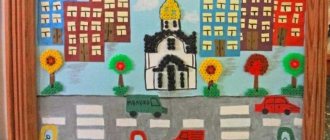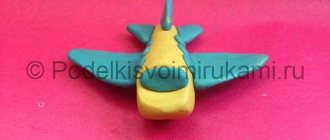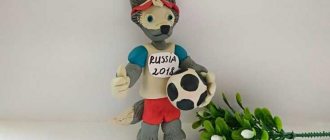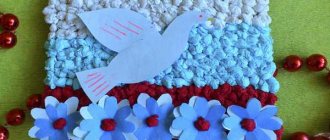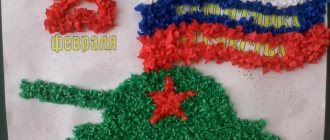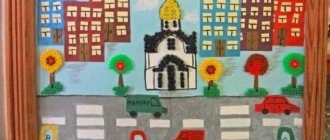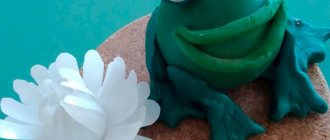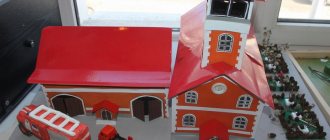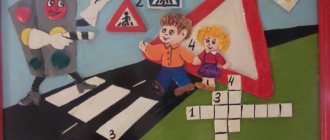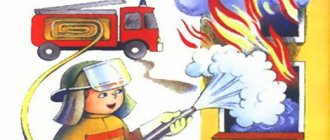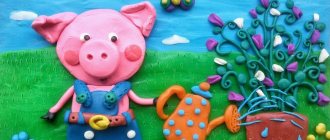Step-by-step instruction
- Prepare the main color for work and the tool. The yellow mass should be thoroughly kneaded in your hands.
- The prepared soft mass can be immediately divided into slices of different formats. The largest piece will be used to sculpt the head, three smaller pieces will be used to create the body and wings of a domestic bird.
- On the ball head, press two triangular holes with a stack. Also knead a small piece of orange plasticine in your hands.
- Insert white cakes into the holes - these will be blanks for the eyes, it is advisable to make them large. Make a beak from an orange piece and attach it to the head.
- Place blue cakes on the white cakes first, then black cakes. After that, add small white highlights.
- Stretch the small piece intended for the body into an oval. Press one side of the oval with two fingers, highlighting the tail. Using the sharp side of the stack, apply stripes to the ponytail.
- Insert a match into the front. Lift the tail slightly up.
- Press the remaining two flatbreads on top onto the board with your fingers. Squeeze on both sides with your fingers, releasing droplets-wings.
- Using a stack, apply the same pattern to the wings as to the tail.
- Glue the wings to the body.
- Prepare orange balls for the paws, press them down with your fingers.
- Make the resulting cakes triangular. Apply 2 strips on each in a stack, highlighting your fingers.
- Attach the legs to the body.
- Add a head to the match.
How to make a duck from plasticine
Modeling animals and birds is the most popular subject of creative activities, which is due to the wide choice for children's creativity. It is recommended to begin the development of creative skills by sculpting such simple figures as a duck. By gradually performing certain actions, the child will be able to make a bird both independently and with the help of an adult.
A simple duck version
The easiest way to sculpt a duck involves performing the following steps in the prescribed sequence:
- You need to prepare material in brown, burgundy, orange and green. Two large balls are rolled out of dark plasticine, a medium-sized ball from green, and a small ball from yellow.
- The brown ball is the body of the future duck. It is necessary to pull it to one side and press down a little, giving it stability.
- Burgundy material will be needed to make the neck and head. The parts must be connected to each other.
- From drop-shaped blanks made of burgundy and green colors, you need to fashion two wings.
- Using a stack, feathers are drawn on the wings. The wings are glued to the sides of the duck's body.
- Two indentations for the eyes are made on the head: two balls of white plasticine are inserted into the dimples on the head.
- An orange tint will be needed to make a flat beak and, bending it slightly, stick it in the center of the head.
- Once all of the above steps are completed, all that remains is to finish drawing the eyelashes and eyebrows.
Modeling a little duckling
The little duckling is a simplified version of the craft that even a child can handle. Yellow plasticine will be used as a base: the feathers of the chicks are exactly this color.
In order to make a little duckling, you will need to perform the following steps:
- Prepare yellow, white, black and red materials and form small balls.
- The body of the bird, the head, and the wings will be made from yellow plasticine. One piece is divided into three parts, the largest of which will become the body of the duckling, the middle one will become the wings, and the small one will become the head. When ready, the parts need to be connected to each other.
- You need to form a beak from red plasticine and stick it to the center of the head.
- All that remains is to make the eyes from black and white plasticine and attach them to the head.
Duck using natural materials
The use of natural materials is an excellent opportunity to realize the most daring creative ideas.
In order to make a duck from natural material, you will need to prepare:
- Cones
- Plasticine of different colors
- Grass and pebbles
- Blue cardboard
- Glue gun
- Paints and brush
A duck made from cones is a craft for which the child will need the help of an adult:
- From brown plasticine it is necessary to form the head and neck of the future duck.
- The green mass is the plumage of a bird. It is glued to the body blank.
- It is necessary to sculpt a beak from a material of a light brown or mustard shade and fix it in the center of the head.
- The duck's eyes will be made of black and orange material: you need to form two balls of each shade. The black balls should be smaller than the orange ones. Bright flattened blanks are attached to the sides of the head, and black balls are glued to them.
- Red plasticine is for paws. They form and attach to the bottom of the bud.
- You will need cardboard to create the base: you need to cut out an oval.
- Cardboard is an imitation of a lake: grass is placed on one side and pebbles on the other. For reliable fixation, you must use a glue gun. The finished duck can be seated in the middle of the lake: the craft is ready.
Modeling a duck outline of a lesson on applique, modeling (middle group) on the topic
Summary of GCD for modeling in the middle group
Duck theme
1. Goal: to teach children to sculpt an object consisting of several parts, showing some characteristic features (an elongated beak, a tail).
Tasks: - Reinforce modeling techniques: rolling the dough between the palms; - Practice using pinching and pulling techniques; - Strengthen the ability to connect parts, pressing them tightly against each other, and smoothing the seams; — Cause a positive emotional response to the overall result.
Vocabulary work: beak, tail.
2. Methodological techniques: verbal (guessing riddles about a duck), visual (examining a toy duck with children), explanation (what is the shape of the body, what is the head, beak, tail).
3. Materials and equipment: salted colored dough; boards; napkins; for each child there are toys - a diagram for sculpting a duck); toys – pet birds; musical accompaniment (dance of little ducklings).
4. Organize children in classes into subgroups.
5. Preliminary work. Conversation with children about poultry (geese, ducks, chickens); looking at illustrations of ducklings, chickens, geese, goslings; game “How are they similar? What is the difference?" (comparison of chicks and ducklings); guessing riddles about birds.
Progress of the lesson.
(Getting a riddle) She walks in the rain, loves to cut grass! "Quack!" shouts, This is all a joke, Well, of course, it’s... (Duck!) - Well done, guys, but here’s another riddle. Amazing child! Just came out of diapers Can swim and dive, Like his own mother (Duckling!)
- Well done! So you guessed it. This is a duck and ducklings.
- Guys, the ducklings were playing, swimming and lost their mother, and they began to call their mother “Quack-quack-quack!”, but mother did not respond. The ducklings ask you to help find their mother duck. Let's help them! How can we help them, guys? (answer options): ... you can blind...
- Of course, you can make a duck! But first, let's play with you a little. The ducks came out into the meadow, (we walk like ducklings) - Quack-Quack-Quack! A cheerful beetle flew by - Zhzhzhzhzh! (we wave our arms - wings). Geese arch their necks - Ga-Ga-Ga (circular rotation of the neck). The feathers are straightened with the beak (the body turns left and right). The wind swayed the branches (we swing our arms up), Sharik also growled - Rrrrr... (hands on the belt, bending forward, looking in front of us). The reeds whispered in the water - Shhhhhhhh... (raise your arms up and stretch), And again there was silence - Shhhhhhh... (crouched down). - Well done! Now sit down at the tables, we must help the ducklings. Look, guys, what wonderful colored dough is on our plates. Touch it, what is it like?.. (Soft, yellow...). - Look, children, what parts does a duck consist of? (Head, torso. Head is smaller, torso is larger). -What do you think this is? (Beak, tail).
- Well done! First you need to divide the dough into two parts. One piece of dough, which is larger, will be the body; a smaller piece is the head. To sculpt the body of a duck, we need to take a larger piece of dough and roll it into an oval with our palms. Then we also sculpt the head, only with a ball. Next, we connect these two parts, pressing them tightly against each other. But be very careful so that the shape does not break. Then we guys, by pinching, make a beak on the duck’s head and pull it back a little, and on the body, where the tail should be, we pull it out. Look how I do it. Our mother duck is almost ready. Is she missing some eyes or something else? (Wings!) - Look, you have buckwheat cereal on your plate, make eyes out of it for the duck. Carefully! Where the eyes should be, press the grain. If everything is clear, get to work. (Music sounds, children get to work). - Our ducklings in the pond are really waiting for their mothers - ducks! (The children finished their work).
Educator: Now, guys, let’s go and put all the mother ducks on the lake. There is a fish in the pond, and ducklings love to eat this fish in the mornings, in the mornings and evenings. And of course at lunch too! The fish will help them grow!
How many ducks! Let's count them guys! Well done, you did a great job today! Look how happy the ducklings are! And the duck is happy too! Everyone has fun, and so do we! After all, we did a good deed. Is it true? (Yes)
- Guys, let's dance the “little ducklings” dance. Please everyone stand in a circle. Now listen to the music and repeat all the movements after me.
(Music sounds. Children dance the dance of little ducklings). - What great fellows you are! I and the ducklings thank you for the wonderful dance.
Children's master class on plasticineography "Fidget Duckling"
Elena Varakina
Children's master class on plasticineography "Fidget Duckling"
Children's master class on working with plasticine “ Fidget Duckling ”
plasticineography technique Hello! Today we, the children of the 2nd junior group No. 5 “Pochemuchki”, want to show you a master class on plasticineography “ The Fidget Duckling ”. Plasticineography is a very interesting and fascinating technique for working with plasticine . It consists in the fact that we paint over the drawing inside the outline not with paints and gouache, but with small balls of plasticine . Also, work can be done not only in the form of gluing small balls onto a drawing, but also by smearing plasticine along the contour of the drawing . plasticineography with great pleasure .
Participants of the master class : Children 3-4 years old and teacher E. N. Varakina.
To create we need:
1. Picture of a duckling with a thick outline
2. Yellow and red plasticine
Progress of the lesson:
Greeting game “Our smart heads”
Our smart heads will think a lot, cleverly. The ears will listen, the mouth will speak clearly. Hands will clap, Feet will stomp. Our backs straighten, we smile at each other.
Surprise moment "Who's in the chest?"
Let's open the chest and see who came to visit us today. Who is this? This is a duck with ducklings. Mom is a duck. And children are ducklings. And their dad is a drake. Look at the ducklings. What do they have instead of a nose? Beak. And instead of legs? Paws. Ducks can walk and swim. What do ducks have? What helps them fly? Wings.
Didactic game “Ducks on the Pond”
Children move three-dimensional figures of yellow and white ducks around the picture.
Let one white and two yellow ducks swim. Here are the ducks lined up one after another. The ducks turned their beaks towards each other. The ducks came out to the shore. Let only one duck into the water. Now one more. How many ducks are swimming in the pond now? Two ducks. How many ducks are left on the shore? One duck.
Drawing with pencils “Guide the duckling to the water”
Children use a blue pencil to draw straight lines from the ducks to the pond. Then the pond is painted over.
Didactic game “Different ducks”
Count how many ducks you have. Three ducks. Are they the same or different? Different. Show the biggest duck, the smallest, the middle one. Find the shadows of these ducks and place them on top. Attach the appropriate size wings to the duck. Put hats on the ducks and hand out balls.
Sample of completed work.
Material for cutting.
Game with clothespins “Make a beak for a duck”
What color clothespins will we use for the duck beak? Let's take red clothespins and make a beak. Like this. (Show). How many red clothespins should you take? Two red clothespins.
Exercise “Feed the duck”
Place three beans in the duck's beak.
Application “Ducks swim in the pond”
Children paste colored silhouettes of ducks onto a background with a picture of a pond.
Dynamic pause “Ducklings are swimming”
Children perform movements to the music according to the lyrics of the song.
Reading a nursery rhyme with onomatopoeia “Our ducks in the morning”
Our ducks in the morning - quack-quack-quack! Quack-quack-quack! Our geese by the pond - Ga-ga-ga! Ha-ha-ha! And the turkey in the middle of the yard - Ball-ball-ball! Bullshit! Our little walkers at the top - Grru-grru-ugrr-u-grru-u! Our chickens through the window - Kko-kko-kko-ko-ko-ko-ko! And how Petya the cockerel, Early, early in the morning, will sing to us cuckoo!
Didactic game “Duck Eggs”
Place as many eggs in the nests as the number you see on it. Place one egg in the nest with the number “1”. Place 2 eggs in the nest with the number “2”. Place 3 eggs in the nest with the number “3”.
Construction of a “Stool for ducklings”
Place the duck on the cube. Will another duck fit on this cube? No, there won't be room for more ducks. Let's make a bench. So that all the ducks can net on it. Take two cubes and place them at a distance from each other. Place a block on top. Now try to seat all the ducks on the bench.
Finger painting "Duck"
Children use their fingers to paint the image of a duck with yellow paint and the beak with red paint.
Exercise “Pour water for the duck”
Children use a pipette to collect water and pour it into a shallow container.
Didactic game “Place pancakes in frying pans”
Nowadays pancakes are baked in all houses. Because Maslenitsa week is coming. So the duck decided to bake pancakes for her ducklings. Help place the pancakes in appropriately sized pans.
Modeling "Pancakes"
Children make pancakes from salt dough and place them on a plate on top of each other.
Then there is a pancake tasting. After the tasting, children perform dance moves to the music “Ducklings”.
Download the summary of the game lesson “Ducklings.
Maslenitsa" in the nursery group of the Lepka kindergarten .
“Big duck with ducklings” Program content. Continue to introduce children to Dymkovo products (duck with ducklings, rooster, turkey and others). Teach children to highlight elements of toy decoration and notice the beauty of form. Induce a feeling of joy and a desire to sculpt toys. Learn to sculpt figures on a stand, convey differences in the size of objects and individual parts, and divide clay in appropriate proportions.
Methodology of conducting the lesson. Consider the toy duck. Say that a big duck has little ducklings. Note that their body is oval, the head is round, and the beak is flat. Emphasize the imagery of the sculpted figures.
Materials of the book. Dymkovo toys. Board for review.
Rice. 11. Cutting out a circle and an oval for beads for the Christmas tree. Bead options ■
Drawing New Year greeting cards
Program content. Learn to independently determine the content and depict what you have planned. Reinforce technical techniques: use paint correctly, rinse the brush well and dry it. Foster initiative and independence. Develop aesthetic feelings and imagination.
Methodology of conducting the lesson. Show the children several postcards one by one and ask what is drawn. Invite the children to think and say what they will draw. Those who finish the drawing quickly are given the opportunity to draw more. Encourage independence in defining content.
At the end of the lesson, look at the drawings and note the most interesting ones with the children.
Materials for the lesson. Postcards about winter, Christmas trees, and New Year's holidays that are accessible in content. Paints.
Application. "Beads for the Christmas tree"
Program content. Reinforce knowledge about round and oval shapes. Learn to cut the corners of rectangles and squares to obtain oval and round beads, alternate beads of different shapes, stick them neatly, evenly, in the middle of the sheet.
Methodology of conducting the lesson. Consider several different beads with your children and offer to make beautiful beads to decorate the Christmas tree. Show cutting techniques. To say that when gluing it is necessary to alternate beads of different shapes. Invite one child at the board to show how he will do it. Give children the opportunity to practice cutting. Admire the bright multi-colored beads.
Materials for the lesson. Rectangles and squares of different colors, glue, brushes, napkins, scissors.
The connection between the lesson and other aspects of educational work. Preparing for the New Year's holiday, singing songs, learning poems.
Drawing. "Our decorated Christmas tree"
Program content. Teach children to convey the image of a New Year tree in a drawing. To develop the ability to draw a Christmas tree with branches lengthening downward. Learn to use
paints, carefully apply one on top of the other only after drying. Lead to emotional evaluation of work.
Methodology of conducting the lesson. Remember the New Year tree in kindergarten, talk about how the tree was decorated. Clarify the techniques for depicting a Christmas tree by calling 2-3 children for a demonstration. Emphasize the variety of Christmas tree decorations, recall the techniques of painting with paints. Upon completion, display all the work on the board and offer to choose the most elegant Christmas trees.
Materials for the lesson. A sheet of white paper (or any soft tone), gouache in different colors.
The connection between the lesson and other aspects of educational work. Singing New Year's songs, decorating the Christmas tree in a group, participating in a festive matinee.
Lesson in the middle group.
Modeling “Duck” Purpose:
to teach children to sculpt an object consisting of several parts.
Tasks:
1. Reinforce sculpting techniques: separate parts from a whole piece and maintain their size when sculpting, roll the dough between your palms, connect the parts, pressing them tightly against each other, practice using the technique of pinching and pulling;
2. Develop fine motor skills of the fingers. 3. Develop the ability to work in a team, causing a positive emotional response to the overall result. Materials and equipment
: salt dough; boards; napkins; for each child); lake is a mirror; duck mask hats for each child; toys - poultry; musical accompaniment; “Worms” marmalade to encourage children.
Progress of the lesson.
Educator
: Hello, guys!
Children
: Hello!
(The voices of poultry are heard). Educator
: I was just about to feed my poultry.
Will you help me? Children
: Yes
Puzzles
He clucks, clucks, calls the children, gathers everyone under his wing.
Children:
Chicken
Teacher:
Well done, guess another riddle: Red paws, pinches your heels, Run without looking back!
Children
: goose!
Educator:
And you guessed this riddle! Well, now you can’t guess: She walks in the rain, She loves to cut grass! “Quack! " shouts,
This is all a joke, Well, of course it is... Children:
Duck!
Educator:
Well done, guys, here's another riddle.
Amazing child! Just out of diapers He can swim and dive, like his own mother. Children
: Duckling!
Educator:
Well done!
So you guessed it. This is a duck and ducklings. They are not in the yard, they probably went to the lake. Let's go look for them. The teacher and the children approach the table on which the lake is decorated. They surround him from all sides. One duck swims on the lake). Educator
: Look, guys, the duck is swimming alone, you can see the kids are hiding in the grass.
The mother duck felt lonely and began to call them. “Quack-quack-quack! ", but the ducklings do not respond. Mother duck asks you to help find her ducklings. Let's help her! How can we help her, guys? Children
: ... you can make ducklings...
Educator:
of course, you can make ducklings!
But first, let's play with you a little. The ducks came out into the meadow, (we walk like ducklings) - Quack-Quack-Quack! A cheerful beetle flew by - Zhzhzhzhzh! (we wave our arms - wings). Geese arch their necks - Ga-Ga-Ga (circular rotation of the neck). The feathers are straightened with the beak (the body turns left and right). The wind swayed the branches (we swing our arms raised up, Sharik also growled - Rrrrr (hands on the belt, bend forward, look in front of us). The reeds whispered in the water - Shhhhhhhhh (raise your arms up and stretch, And again there was silence - Shhhhhhhh... (crouched) Educator :
Well done! Now sit down at the tables, we must help the mother duck.
Educator:
Look, children, what parts does a duck consist of?
Children
: Head, body. The head is smaller, the body is larger. The head is round, and the body is oval.
Educator :
What do you think, what is this? Children: Beak, tail.
Educator:
Well done! First you need to divide the dough into two parts. One piece of dough, which is larger, will be the body; a smaller piece will be the head. To sculpt the body of the duck, we need to take a piece of plasticine, which is larger, and roll it into an oval in your palms. Then we also sculpt the head, only with a ball. Next, we connect these two parts, pressing them tightly to each other. But very carefully so that the shape does not break. Then we, guys , by pinching, we make a beak on the head of the duckling and pull it back a little, and on the body, where the tail should be, we pull it out.
Look how I do it. Our duckling is almost ready. Is he missing some eyes or something else? Children:
Wings.
Educator
: Look, you have cereal (what kind of cereal) in your plate - buckwheat, make eyes out of it for the duckling.
Carefully! Where the eyes should be, press the grain. (Music sounds, children start the lesson). Educator:
Our duck in the pond is really looking forward to her ducklings!
(Providing individual assistance to children) (Children finished work) . Educator:
Now, guys, let’s go and put all the ducklings on the lake.
Our duck is one, but there are many ducklings! Let's count them guys, see if they all returned to their mother! Children count: 1;2;3;4;5;6;7;8;9;10. You guys are great, you did a great job! Look how happy the mother duck is! And the ducklings are happy too, they have returned to their mother! Everyone has fun, and so do we! Educator:
So that our guests also have a good mood, let's dance for them together with our duck and ducklings.
Please, everyone, stand around the lake, and I will put on duckling hats and masks for you. Now listen to the music and repeat all the movements after me. (Music sounds. Children dance the dance of little ducklings) Educator
: What a great fellow you are! Me and the duck thank you for the wonderful dance. And the duck also wants to thank you for returning the babies to her! She handed you the treat. Now let's not bother our duck and ducklings, let's go play.
2722880152400 MUNICIPAL BUDGETARY PRESCHOOL EDUCATIONAL INSTITUTION KINDERGARTEN No. 28 “RODNICHOK” STANITS OF NOVODONETSKAYA MUNICIPAL EDUCATION VYSELKOVSKY DISTRICT Open display On artistic and aesthetic development (modeling) in the middle group of general developmental orientation on the topic: “ Duck with ducklings" Prepared by: Teacher of MBDOU DS No. 28 "Spring » art. Novodonetskaya Kolupaeva Alla Aleksandrovna Open educational activity Topic: “Duck with ducklings” (Modeling middle group) 1. Purpose: to teach children to sculpt an object consisting of several parts, showing some characteristic features (an elongated beak, a tail). Objectives: Educational: - To consolidate sculpting techniques: rolling plasticine between the palms; - To practice using pinching and pulling techniques; - To consolidate the ability to connect parts, pressing them tightly together, and to smooth seams; Developmental: - Develop imaginative ideas, imagination and creativity. Educational: - Foster a positive attitude towards the results of your activities. Vocabulary work: beak, tail. 2. Methodological techniques: verbal (guessing riddles about a duck), visualization (looking at a toy duck with children), explanation (what shape is the body, what is the head, beak, tail), independence (children’s work), moment (providing individual assistance by the teacher). 3. Materials and equipment: plasticine, boards, napkins (for each child), duck toys, a mirror lake, duck hats and masks (for each child), a house model, wattle fence, toys - pet birds, musical accompaniment, a huge toy egg to encourage children and “Worms” marmalade.4. Organizing children for classes in subgroups. 5. Preliminary work. Conversation with children about poultry (geese, ducks, chickens); looking at illustrations of ducklings, chickens, geese, goslings; game “How are they similar? What is the difference?" (comparison of chicks and ducklings); guessing riddles about birds. 6. Statement of the problem: The ducklings have disappeared. Progress OD. (The music of the voices of domestic birds and animals sounds). Educator: Guess, guys, what birds are we talking about? She walks in the rain, loves to pluck grass! “Quack!” screams, It’s all a joke, Well, of course, it’s... Children: Duck! Educator: Well done, guys, here’s another riddle. Amazing child! Just came out of diapers Can swim and dive, Like his own mother. Children: Duckling! Educator: Great! So you guessed it. This is a duck and ducklings. Come on, guys, we'll go with you to the lake and see how they swim. (Children pass a strip with physical education equipment: a bridge, hummocks. The teacher and the children approach the table on which the lake is decorated. They surround it on all sides. One duck is swimming on the lake). Educator: Look, guys, the duck is swimming alone, you can see, kids hid in the grass. The mother duck felt lonely and began to call them. “Quack-quack-quack!”, but the ducklings don’t respond. Mother duck asks you to help find her ducklings. Let's help her! How can we help her, guys? Children (answer options): ... you can make them... Educator: of course, you can make ducklings! But first, let's play with you a little. The ducks came out into the meadow, (we walk like ducklings) - Quack-Quack-Quack! A cheerful beetle flew by - Zhzhzhzhzh! (we wave our arms - wings). Geese arch their necks - Ga-Ga-Ga (circular rotation of the neck). Straighten the feathers with their beak (turn the body to the right and left). The wind swayed the branches (we swing our arms raised up), the ball also growled - Rrrrr... ( hands on the belt, bending forward, looking in front of us). The reeds whispered in the water - Shhhhhhhhh... (raise your hands up and stretch), And again there was silence - Shhhhhhhhh... (crouched down). Educator: Great, guys! Now sit down at the tables, we must help the mother duck. Look, guys, what wonderful colored plasticine we have on our plates. Touch it... Educator: Pay attention, children, what parts does the duck consist of? Children: Head, torso. The head is smaller, the body is larger. Educator: What do you think, what is this? Children: Beak, tail. Educator: Well done! First you need to divide the plasticine into two parts. One piece, which is larger, will be the body; a smaller piece is the head. To sculpt the body of a duck, we need to take a larger piece of plasticine and roll it into an oval with our palms. Then we also sculpt the head, only with a ball. Next, we connect these two parts, pressing them tightly against each other. But be very careful so that the shape does not break. Then we guys pinched the beak on the duckling’s head and pulled it back a little, and on the body, where the tail should be, we pulled it out. Look how I do it. Our duckling is almost ready. Does he lack eyes and something else? Children: Wings!.. Educator: It's time to get some rest. Physical education lesson Duck early in the morning Leads all the ducklings to the pond. (walking in a circle) Hey, ducklings, don’t be lazy, stand on your toes. (walking on tiptoes) And now on the heels of the Cute Ducklings. (walking on heels) We have come, my children, wash our paws together. (we sit on the floor with our legs stretched forward, stretched out and collected) Oh, cold water! The child screamed. I will teach you to dive, my little yellow ducklings. (head tilts) And now it’s time to fly, We flap our wings skillfully. (wave your arms up and down) Let's take a rest, guys, Let's play hide and seek. (they sat down, covered their faces with their hands, straightened up and opened their faces) Everyone stand behind me, it’s time for us to go home (walking in a circle) And the ducklings keep sighing, walking with a sad face. (inhale through your mouth, exhale through your nose) Don’t be sad, ducklings! Tomorrow, early in the morning, I will take you to the pond again (jumping with clapping overhead - the ducklings are happy) Teacher: look, you have buckwheat in your plate, make eyes for the duckling out of it. Carefully! Where the eyes should be, press the grain. If everything is clear, proceed. (Music plays, the children begin to sculpt). Educator: Our duck in the pond is really looking forward to her ducklings! (The children finished their work). Bottom line. Educator: Now, guys, let’s go and put all the ducklings on the lake. There is a fish in the pond, and ducklings love to eat this fish in the mornings, in the mornings and in the evenings. And in the afternoon, too, of course! The fish will help them grow! Our duck is one, but there are many ducklings! Let's count them! Guys, you did a great job today! Please tell me why we did all this? Children: To help mother duck, because she was so lonely. Educator: Look how happy the mother duck was! And the ducklings are happy too, they have returned to their mother! Everyone has fun, and so do we! After all, we did a good deed. Really? Children: Yes!! Educator: So that our guests also have a good mood, let's dance for them together with our duck and ducklings. Please, everyone stand in a circle around the lake, and I will put on duckling hats and masks for you. Now listen to the music and repeat all the movements after me. (Music sounds. Children dance the dance of little ducklings). Educator: Great, guys! Me and the duck thank you for the wonderful dance. And the duck also wants to thank you for returning the babies to her! She passed on treats. Now let’s not bother our duck and ducklings, let’s go to our group. (Children leave).
: This lesson is aimed at teaching children to convey the characteristic features of ducklings in sculpting: an oval-shaped body and head, a wide beak and a wide flat tail. Continue to learn how to use a stack to create an expressive image. Lead children to plot modeling through joint compositions. Strengthen the ability to divide clay into unequal parts, use previously learned sculpting methods: rolling, rolling, pinching, connecting parts using the technique of smearing. Cultivate sympathy for the game character, evoke a desire to help him.
